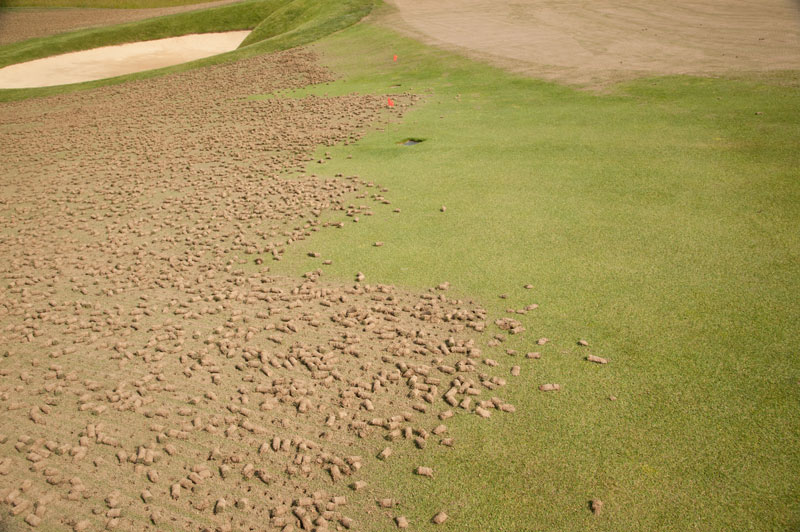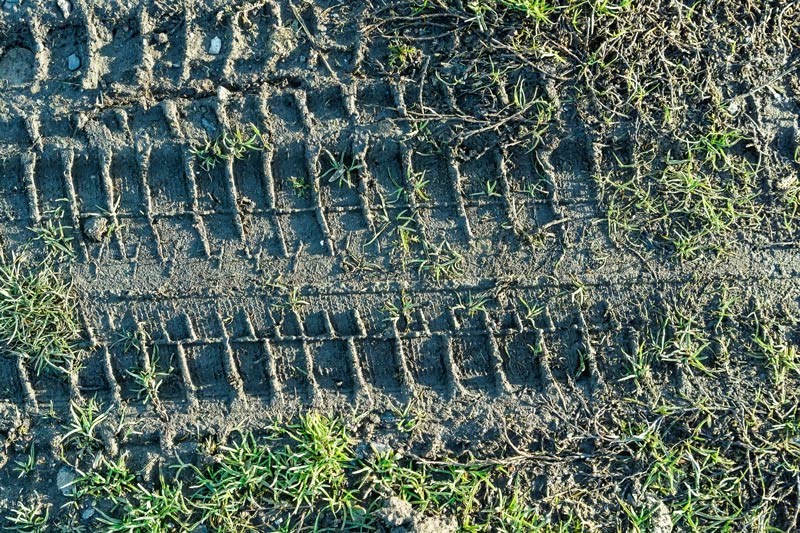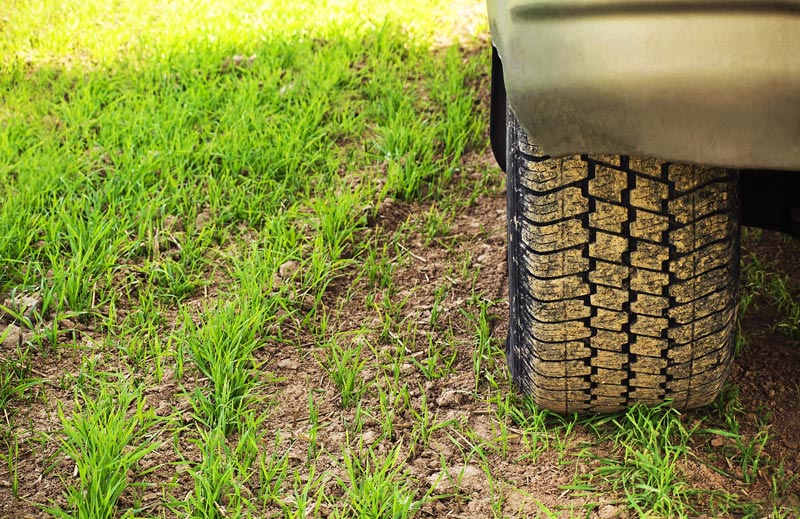
Don’t aerify in vain: If cultivation efforts don’t reach the compacted zone within the soil, turf growth and development will continue to be hampered. Photo by Montana Pritchard
Editor’s note: The following article first appeared in the August 1990 issue of GCM. Because of its timeless insights for turf managers, we’ve dusted it off and are presenting it anew.
Traffic may well be the most important stress affecting golf courses. The projected increase in foot and vehicle traffic from increased play will result in damage from soil compaction, wear and soil displacement. The dominant traffic stress will depend on intensity of traffic, soil, texture, soil water content and plant density.
Wear, which is the physical abrasion of leaf tissue, occurs on heavy-traffic sites, especially on dry sandy soils.
Soil displacement or rutting occurs on saturated soil when loads are heavy. Because all pore spaces are full of water, the weight displaces the soil rather than oxygen.
Soil compaction is the pressing together of soil particles into a denser mass, resulting in a reduction of air-filled pore space. Heavy soils with soil water contents near field capacity are more prone to soil compaction when subjected to heavy loads or frequent traffic.
Soil compaction is not limited to heavy soils. It may occur on high-sand-content greens, especially if the greens are poorly constructed.
Soil compaction has been called a “hidden” stress because its effects may not be readily apparent. Compacting a soil during favorable growth conditions may not result in deterioration of the turfgrass until other environmental stresses have occurred. Understanding the effects of soil compaction on plant growth will help golf course superintendents understand soil compaction as a major stress. They will then be able to deal effectively with compaction on their golf courses.
Soil compaction indirectly affects plant growth by decreasing soil aeration and increasing soil strength, soil water holding capacity and soil temperatures. By studying plants growing under these conditions, researchers have been able to demonstrate the effects of soil compaction on root growth and activity, shoot growth, nutrient uptake, plant water use, and carbohydrate reserves.
Root response to soil compaction
The effects of soil compaction on root growth and activity have been documented by altered root distribution and increased root porosities.
Data from research conducted by Agnew and Carrow in 1984 indicated that soil compaction resulted in increased root growth near the surface while deep rooting decreased. Shallow roots result in decreased water and nutrient absorption. Thus, the golf course superintendent needs to irrigate lightly and frequently. This results in poor use of valuable irrigation water.
In the same study, the amount of pore space within the root (root porosity) was determined. The roots demonstrated an increased root porosity when grown under compacted soil conditions for 99 days. Although the increased root porosity may initially help the turfgrass plant survive low soil oxygen levels, it is a result of the breakdown of cell tissue. Thus, any benefits of increased root porosity may be short-lived over a long period of time.
Soil compaction effects on shoot growth
The effects of soil compaction on shoot growth have been documented by reduced visual quality, decreased shoot density and rhizome development, and reduced clipping production. These responses are understandable, because water and nutrient uptake are adversely affected by altered root distribution.
In a field study conducted by Agnew and Carrow in 1983, visual quality was not affected by soil compaction until after the onset of high temperatures in July. Before the July heat stress, little difference was recorded in quality. After the July heat stress period, quality decreased as the compaction level increased. A similar decrease in quality is not uncommon on golf course fairways and greens during summer.
Shoot density and rhizome development are decreased by soil compaction. Reduction in shoot density and rhizomes does not always show up immediately after soil compaction. This response to soil compaction may be a result of the combined altered root growth and high evaporative demand.
Clipping yields are also decreased by soil compaction. Unlike other shoot responses, the decrease in clipping yield is an immediate response. Vertical leaf growth can be decreased by 70% following soil compaction. This response indicates that corrective measures should be taken before further injury occurs.
Editor’s note: A superintendent outlines his method of tracking clipping volume and interpreting the data, and answers fellow turf managers’ frequently asked questions.
In general, the effect of reduced shoot growth is a decrease in total photosynthate production and in the recuperative potential of a turfgrass plant.
Turfgrass physiological response to soil compaction
In addition to reducing shoot growth, soil compaction will alter nutrient uptake, plant water status and carbohydrate reserves.
Early research reports have documented the effects of soil compaction on nutrient uptake, which appears to be reduced in the following order: K > N > P > Ca > Mg. Restricted root growth, slower shoot growth and a barrier to soil water flow combine to alter nutrient uptake.

Soil compaction decreases plant growth, which in turn inhibits plant metabolism. Photo by Adobe Stock
Plant water status can be adversely affected by soil compaction. In research conducted by Agnew and Carrow, evapotranspiration declined in Kentucky bluegrass growing under compacted soil conditions. However, water use increased in the same sites.
The decline in evapotranspiration was due to closure of stomates, which in turn resulted from less available soil moisture. Plants with an extensive root system had better evapotranspiration rates, and the stomates remained opened during critical time periods for cooling the plant. These plants had canopy temperatures 10 F less than plants growing in compacted soils.
Editor’s note: See Water in turfgrass: Functions, flow and forms for more on the water-turf interplay that makes golf’s playing surfaces possible.
In addition, plants growing in compacted soils are more subject to temperature extremes that will cause the deterioration of physiological and morphological parts of the turfgrass plant.
Another physiological response affected by soil compaction is total nonstructural carbohydrates (TNC), which refers to the soluble sugars and carbohydrates in the plant. It is an important constituent within the plant that has been linked to recuperation and hardiness.
In research conducted by Carrow in 1979, compaction reduced TNC in three plant species. This indicates that plants growing under compacted conditions are less likely to survive adverse environmental conditions. The superintendent who doesn’t aerify golf course greens in fall may experience greater winter desiccation.
How to alleviate soil compaction
The adverse effects of soil compaction on plant growth are severe and long-lasting. It is important to alleviate soil compaction as soon as it has been identified. This is best done with cultivation.
There are several types of cultivation practices available to alleviate soil compaction, including core cultivation, water injection, grooving, slicing and spiking.
Core cultivation, which involves the removal of cores with either hollow tines or spoons, is still the best means of alleviating soil compaction. The closer the tines are spaced, the more effective the cultivation treatment. Furthermore, it is important to penetrate the compacted zone within the soil. If this is not done, a barrier will still remain that will prevent growth and development of the turfgrass.
Cultivation methods that slice into the ground provide only temporary relief to compaction stress. These methods include grooving, slicing and spiking. They can provide increased water infiltration, but they do not alleviate the low soil oxygen levels that exist in compacted soils.
New methods of cultivation, such as deep-tine aerification, may provide compaction relief of deeper compacted zones within the soil. These compaction layers may be built up over the years because of topdressing practices.

Compacted soil produces plants that are less likely to survive adverse environmental conditions. Photo by Adobe Stock
In summary, soil compaction decreases plant growth, which in turn inhibits plant metabolism. The decreased plant metabolism can predispose the turfgrass plant to injury by drought and high temperature stresses.
Environmental stresses have been documented by increased canopy temperatures and reduced recuperative potential. Alleviating soil compaction before the onset of secondary environmental stresses will help prevent unnecessary problems for the golf course superintendent.
Michael L. Agnew is a technical manager for Syngenta. He earned a Ph.D. in horticulture with a specialization in turfgrass science and plant stress physiology from Kansas State University.